On May 26th the Moon will be in total eclipse for the first time in nearly two and a half years. While timing favors western North America, a partial eclipse will be visible across much of the U.S. and Canada at dawn.
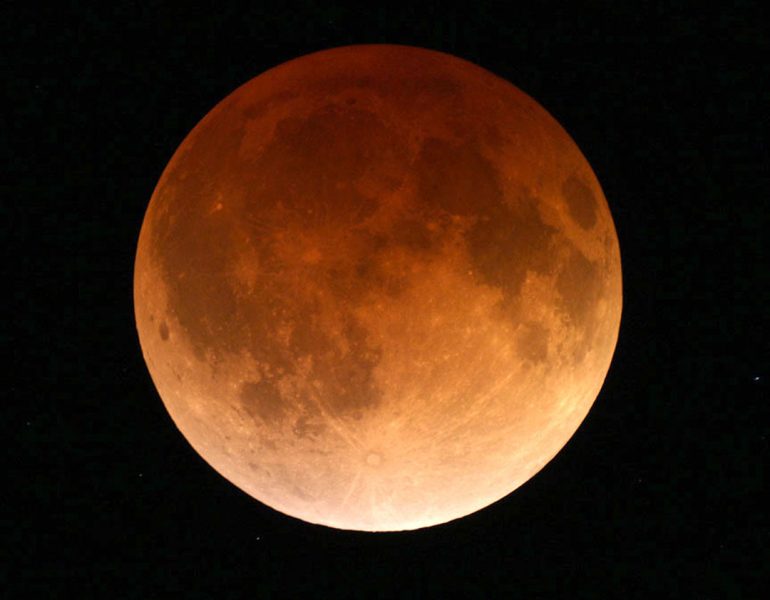
If it feels like a while since the Moon took a deep dive into Earth's shadow, you're right. The last total lunar eclipse occurred on January 21, 2019, followed by four penumbral eclipses in 2020. Wait no more! On May 26th, observers in the western half of North America, western South America, East Asia, and Australia will once again see the Moon fully eclipsed.
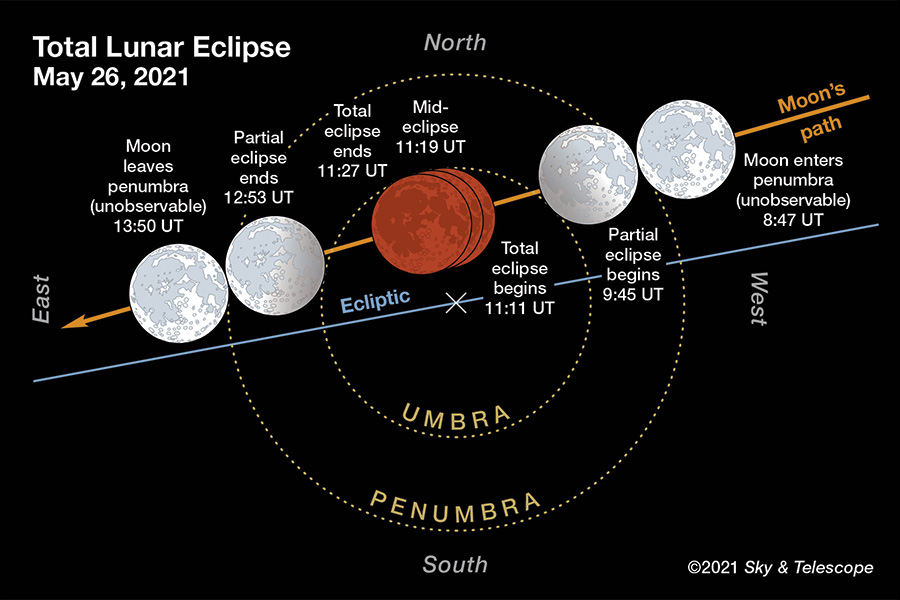
Leah Tiscione / S&T; Source: USNO
This eclipse will be short and sweet much like the total solar variety, with the Moon spending just 15.9 minutes inside the umbra, Earth's central shadow. The brief visit is due to two factors. First, the Moon passes well north of the umbra's center with its northern limb nearly tangent to the umbra's edge. Minutes after it enters the shadow, it pushes out the other side.
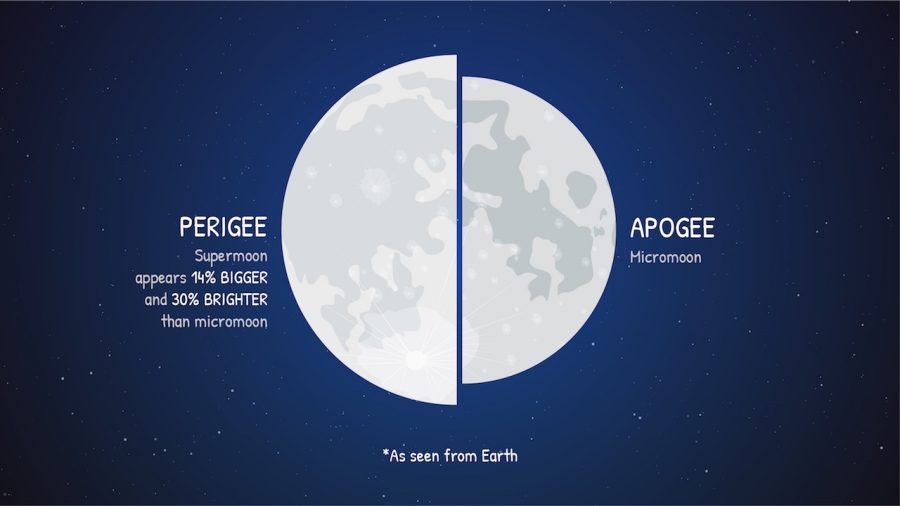
NASA
Secondly, the eclipse happens to coincide with a perigean full Moon (known popularly as a supermoon). In fact, May's Flower Moon is the closest full Moon of the year. Perigee, the point in its orbit of closest approach to the Earth, occurs on May 25th at 9:53 p.m. EDT, only about 9.3 hours before mid-eclipse. Distance from the Earth affects both the Moon's apparent size and velocity. The full Moon's average apparent diameter is 31′, but during May's totality it will be 33.6′ across, a difference of about 8%. This extra-large Moon makes for a slightly tighter fit within the umbra, leading to a quicker egress.
NASA's Visualization Studio
The Moon will also be traveling faster along its orbit. On May 11th when it was at apogee, its most distant point from the Earth, it clocked in at 3,528 kilometers per hour (2,192 mph). During totality on the 26th, our satellite will be sailing along almost 250 kilometers an hour (155 mph) faster. The extra speed hastens its exit from the shadow.
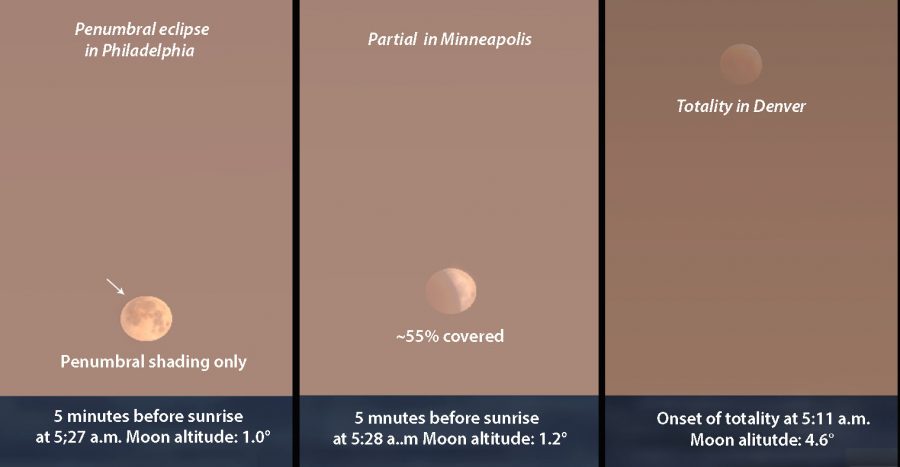
Stellarium with additions by the author
Where and when to see the eclipse
While totality is restricted to the regions described earlier, half the planet will witness a partial lunar eclipse, from eastern South America to India. Across the U.S. and Canada, the farther west you live, the deeper the Moon appears in eclipse.
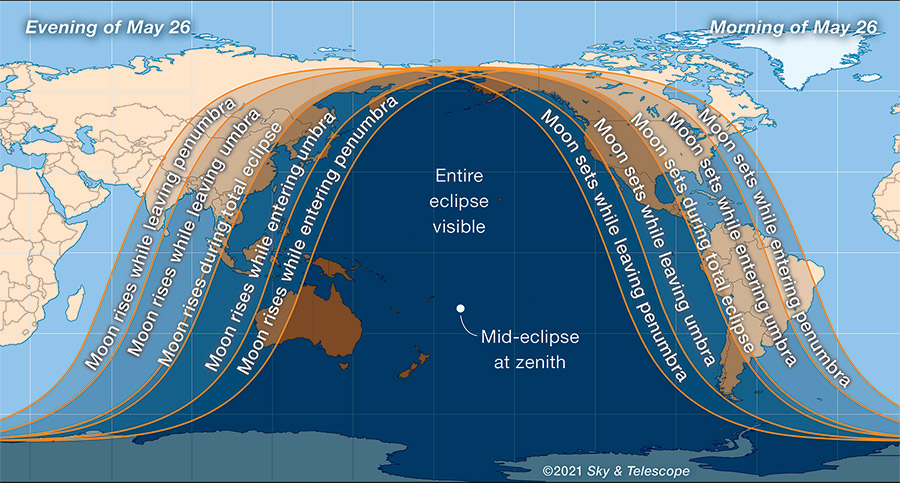
Leah Tiscione / S&T; Source: USNO
From the Eastern seaboard only the early penumbral phase will be visible before the Moon sets around sunrise. From the Midwest about half the Moon will be covered, while from Denver westward, observers will enjoy a total eclipse. Only in the far western states will totality be visible in a dark sky, otherwise this is a morning twilight event. Because the Moon lies in Scorpius well south of the ecliptic, it will shine low in the southwestern sky across much of the U.S. and Canada, so be sure to scout out a spot with an unobstructed view in that direction.
If bad weather interferes or you want to continue observing the eclipse through totality after it sets for your location, the entire event will be livestreamed from three different sites on the island of Hawai'i. One of those streams is unique in that it will be focused on the changing ground scenery and sky rather than on the Moon itself. Others to check out include:
- Lowell Observatory in Flagstaff, Arizona YouTube channel on May 26 from 5:30 a.m. to 7:25 a.m. EDT.
- Griffith Observatory in Los Angeles YouTube channel from 4:45 a.m. to 9 a.m. EDT.
- ESA will also host their eclipse webcast, Lunch with the Moon, from 5:30 a.m. to 7:30 a.m. EDT on both the ESA website and ESA WebTV.
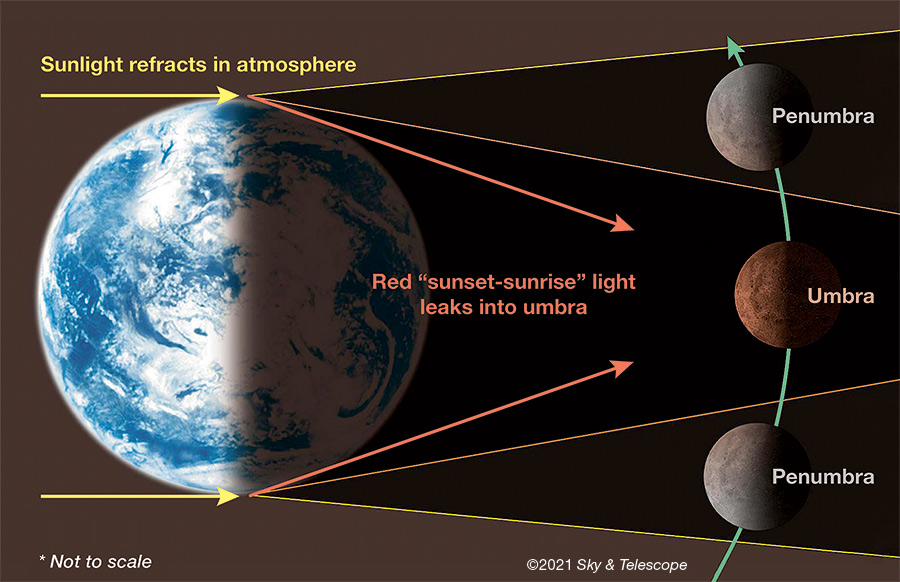
S&T illustration
At the start of the eclipse, the Moon enters the Earth's outer shadow, called the penumbra. Here the planet's globe only partially blocks the light of the Sun, diluting the shadow and making it a challenge to see. But if you pay close attention, you'll notice a gray shading across the eastern third of the Moon about 20 minutes before the Moon enters the dark, inner umbra, marking the start of the partial eclipse.
| May 26 | EDT | CDT | MDT | PDT | AKDT | HAST |
| Penumbral eclipse begins | 4:47 a.m. | 3:47 a.m. | 2:47 a.m. | 1:47 a.m. | 12:47 a.m. | 10:47 p.m. (May 25) |
| Partial eclipse begins | 5:45 a.m. | 4:45 a.m. | 3:45 a.m. | 2:45 a.m. | 1:45 a.m. | 11:45 p.m. (May 25) |
| Totality begins | _____ | _____ | 5:11 a.m | 4:11 a.m. | 3:11 a.m. | 1:11 a.m. |
| Maximum eclipse | _____ | _____ | 5:19 a.m. | 4:19 a.m. | 3:19 a.m. | 1:19 a.m. |
| Totality ends | _____ | _____ | 5:27 a.m. | 4:27 a.m. | 3:27 a.m. | 1:27 a.m. |
| Partial eclipse ends | _____ | _____ | _____ | 5:53 a.m. | 4:53 a.m. | 2:53 a.m. |
| Penumbral eclipse ends | _____ | _____ | _____ | _____ | _____ | 3:50 a.m |
Partial eclipse begins when the umbra takes that first nibble from the lunar limb. Not long after, when roughly a quarter of the Moon has entered the inner shadow, its reddish hue becomes noticeable without optical aid. The color comes by way of our atmosphere, which refracts reddened sunlight grazing the planet's circumference into the depths of the umbra. Sans atmosphere, the Moon would be completely invisible during totality.
Fun eclipse projects
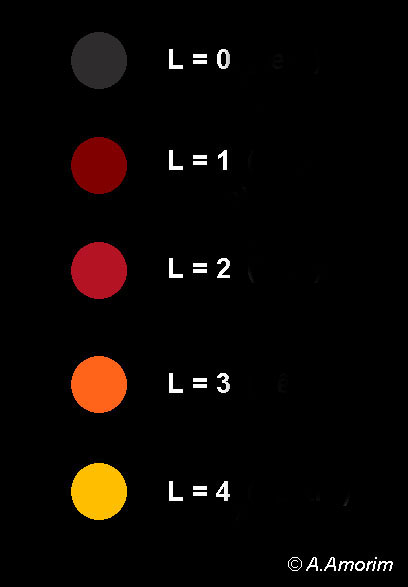
Alexandre Amorim
The Moon's color in the shadow ranges from a bright copper to a deep maroon-brown, influenced by how centrally it passes through the umbra as well as the amount of suspended aerosols in the Earth's atmosphere at the time of eclipse. The more material, the more light absorbed and the darker the Moon. Besides noting the Moon's color and brightness you can also make crater timings to determine the size of the Earth's shadow. Be sure to check out Roger Sinnott's recent Useful Projects for a Lunar Eclipse for details.
I suspect May's totality will be a bright one if only because the Moon barely scrapes through the umbra. During its brief foray, watch for ozone in the upper stratosphere to work its magic. Ozone absorbs red light and colors the outermost fuzzy fringe of the umbra blue, a sight best seen in binoculars or a telescope.
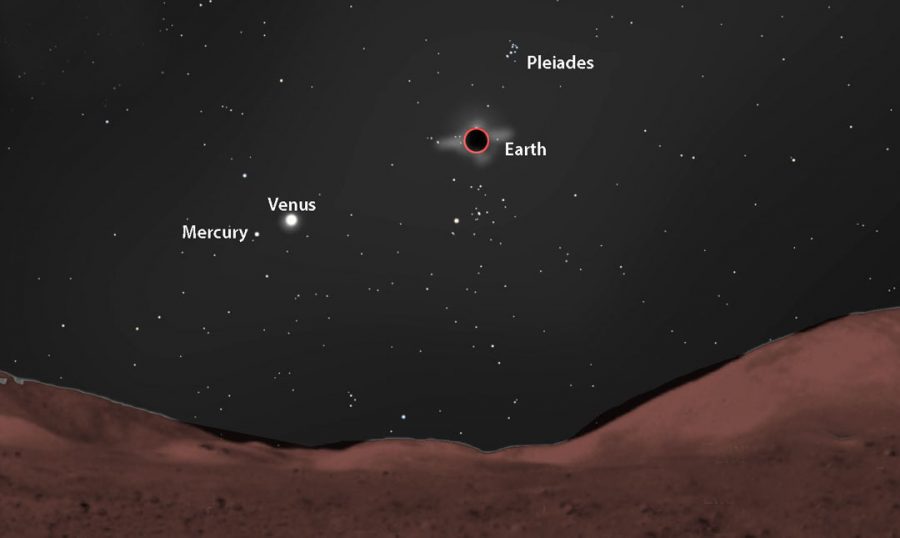
Stellarium
During any phase of the eclipse — but especially during totality — watch for potential meteoroid impacts. They'll appear as momentary flashes of light on the darkened moonscape. Amateurs captured one of the best-known impact flashes on video during the 2019 eclipse. If you have a second telescope and video capability, consider dedicating that instrument to impact recording. For still photography tips I recommend Fred Espenak's How to Photograph a Lunar Eclipse.
If you're lucky enough to see totality from the countryside, you'll experience the full eclipse aesthetic as the sky transitions from bright moonlight to black velvet. With the Moon in shadow, thousands of stars return to view along with the grand arch of the summertime Milky Way. Maybe it's just synesthesia, but when moonlight is quenched at totality, a hush seems to settle over the land.
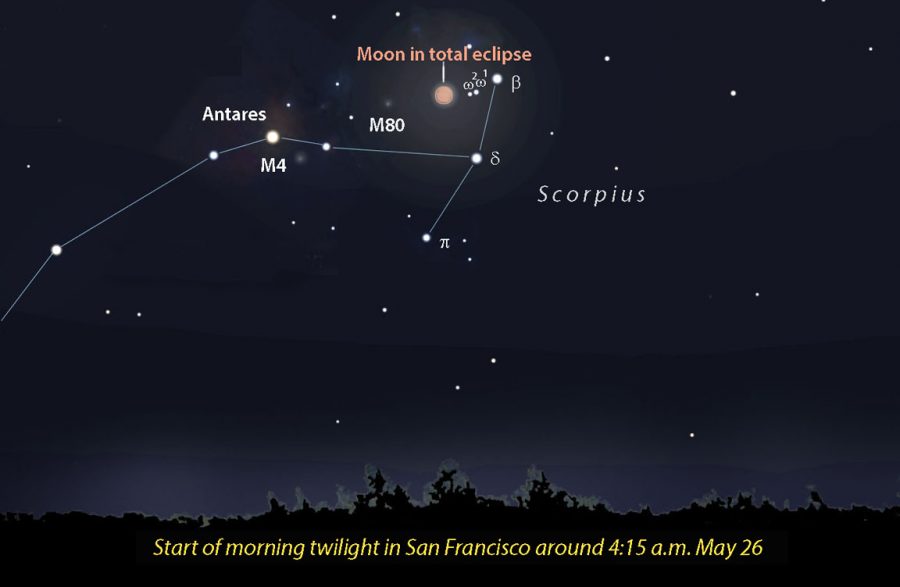
Stellarium
During the eclipse, the Moon will appear very close to a pair of 4th-magnitude stars, Omega1 and Omega2 (ω1, ω2) Scorpii, and about 1° southeast of the beautiful double star Beta (β) Scorpii. Antares lies about 6.5° southeast. One or both of the Omegas will be occulted around eclipse time from Mexico, Central America, and parts of South America. Beta will be occulted prior to the eclipse from southern South America.
Whatever percentage of the Moon is covered, I wish you clear skies. Don't forget. You're part of this celestial alignment, too!
If you're interested in reading more about this and other celestial events this month click here to purchase a copy of the May issue of Sky & Telescope.
 18
18









Comments
misha17
May 20, 2021 at 3:16 pm
Back in April 2015, there was a similar circumstance for a lunar eclipse when the moon was barely entirely within the umbra. There was discussion on the actual shape and size of the earth's shadow, since the earth polar circumference is slightly smaller than the earth's equatorial circumference. Also, the Earth's atmosphere bends light and around the edge of the earth, so the "true" umbra where the sun appears totally obscured may be different (smaller) than the "calculated" umbra. Since moon passed so close to the northern (polar) limit of the calculated shadow, there was some argument as to whether that eclipse was truly total or only a very deep partial eclipse.
Sky and Telescope, April 3, 2015: "SATURDAY'S LUNAR ECLIPSE: NOT TOTAL?"
https://skyandtelescope.org/astronomy-news/observing-news/april-4th-lunar-eclipse-not-total-040320156/
Estimates for that eclipse's totality varied from 10 minutes to only 4 minutes to none at all (Deep partial eclipse).
This article mentions that totality will be 16 minutes long; which organization is the source of this information?
You must be logged in to post a comment.
Bob KingPost Author
May 21, 2021 at 12:52 am
Dear misha17,
Excellent points and great question. There was much discussion about which eclipse times to use. In the magazine article, which was written several months ago, USNO times were used. But it was decided to go with the Herald-Sinnott values from the recently published 21st Century Canon of Lunar Eclipses (http://astropixels.com/pubs/21CCLE.html) and the Eclipse Almanac: 2021 To 2030 (http://astropixels.com/pubs/EclipseAlmanac.html) for this article.
You must be logged in to post a comment.
misha17
May 21, 2021 at 2:28 pm
Having re-read the April 2015 article, that eclipse was touted as the shortest total lunar eclipse of this century. ~If~ that eclipse was really only a deeply partial eclipse, and ~if~ this eclipse really is a (barely) total lunar eclipse, then this month's eclipse is the shortest total lunar eclipse of the century.
Looking at the stats on Fred Espanek's website, this month's eclipse
http://www.eclipsewise.com/lunar/LEprime/2001-2100/LE2021May26Tprime.html
is only barely shorter than the total lunar eclipse of Oct 21, 2097
http://www.eclipsewise.com/lunar/LEprime/2001-2100/LE2097Oct21Tprime.html
You must be logged in to post a comment.
Bob KingPost Author
May 21, 2021 at 3:44 pm
Misha,
Very interesting! Note that Fred uses older numbers for totality length (circa 2014) and shows totality at 15 minutes for the upcoming eclipse when according to the newer method it's 15.9 minutes.
You must be logged in to post a comment.
Yaron Sheffer
May 20, 2021 at 3:20 pm
Bob, thanks for the article, but here near Philadelphia the prospects are dim 🙁
1971 was my best year: Aug 6, lunar totality of 99 minutes, a few degrees from the Aug 10 opposition spot of Mars, shining at -2.85 mag from only 0.3757 AU away... Both events were almost the bestest in their respective categories, but together they almost turned the landscape red... 🙂
You must be logged in to post a comment.
Bob KingPost Author
May 21, 2021 at 12:56 am
Hi Yaron,
I totally (excuse the pun) understand. Your situation is fringy with only a penumbral shadow just before moonset. November's eclipse, though not total, will be much better!
You must be logged in to post a comment.
Anthony Barreiro
May 21, 2021 at 4:12 pm
I wish somebody would put a small optical telescope on the Moon's near side, transmitting a real-time video image of the Earth accessible over the internet. It would be cool to be able to look at the Earth from the Moon at any random time, and especially interesting when the Moon is eclipsed. I guess the telescope would need a solar filter around the time of full Moon, and it would need to know to remove the filter during total lunar eclipses.
You must be logged in to post a comment.
Anthony Barreiro
May 21, 2021 at 5:29 pm
P.S. Thanks for the San Francisco preview! The weather forecast is promising.
You must be logged in to post a comment.
Rfeldman
May 21, 2021 at 4:28 pm
I'm surprised by the phrase "Because the Moon lies in Scorpius well south of the ecliptic," as I always assumed, as confirmed elsewhere on the skyandetescope.com website, that having the moon crossing the ecliptic was a necessary condition for an eclipse. Should it be "Because the Moon lies in Scorpius well south of the equator," or ""Because the Moon lies in Scorpius well south on the ecliptic,"? Thank you.
You must be logged in to post a comment.
misha17
May 21, 2021 at 4:58 pm
Rfeldman, you're right, it should read, "well south of the (celestial) equator, ..." And the diagram at the top of the article shows that for this eclipse, the moon is passing north of the ecliptic.
You must be logged in to post a comment.
Ali-Ebrahimi Seraji
May 24, 2021 at 6:16 pm
Hi Bob,
I saw a total short-lived eclipse on November 9, 2003. It took 22 minutes and the southern edge of the moon was bright white.
You must be logged in to post a comment.
Bob KingPost Author
May 24, 2021 at 9:01 pm
Hi Ali,
Nice to hear from you! That may well happen again this time around. We'll soon see.
You must be logged in to post a comment.
misha17
May 26, 2021 at 1:55 am
Ali,
That eclipse was one Saros cycle ago. The next eclipse in that series will occur this November, but it will only be a deep partial eclipse, not quite total.
https://en.wikipedia.org/wiki/Lunar_Saros_126
Likewise, this week's eclipse is the last total eclipse of its Saros series. The next one in the cycle will be a deep partial eclipse in June 2039
https://en.wikipedia.org/wiki/Lunar_Saros_121
You must be logged in to post a comment.
Kenneth Schroeder
May 25, 2021 at 8:24 pm
DEFINITELY LOOK FOR ANOTHER METEOROID IMPACT!
I saw the meteoroid impact during the last 2019 eclipse visually and in real-time with only my Canon binoculars. The report was officially accepted. The original report is pasted below.
**********************************************************
January 25, 2019 at 9:20 pm
REPORT OF VISUAL REAL TIME OBSERVATION OF LUNAR ECLIPSE IMPACT
I observed this lunar meteoroid impact visually, in real-time, using a pair of handheld Canon 10x42 image-stabilized binoculars. I was observing from Auburn, WA, USA from a covered balcony. Partial light clouds were present during the early eclipse but skies had cleared by the time of impact at 8:41 pm PST on 1/20/2019. The moon was at an approximate altitude of 38° with no obstructions.
Visually, the flash was extremely brief, maybe 2/10 second,s and a pinpoint of white light. The flash was bright enough in binoculars to immediately catch my attention. There was no hesitation or waffling as to what the flash was and I thought "meteor” instantly. The Canon binoculars have a field of view of 6.5° so the full lunar disc was visible. My view at impact was on the center of the moon so the flash appeared almost directly down (vertical) in my field of view very close to the lunar edge which was in full shadow. The impact was not in my visual blind spot which might have prevented the sighting. I continued to look for more flashes with the binoculars for about one minute but none were evident.
During the five minutes before impact, I had a Swarovski 20x-60x ATS 65mm spotting scope coupled to my Samsung Galaxy S8 phone. The phone camera was taking time-lapse images every 5 seconds. About one minute after the impact I removed the camera to scan with the scope at the location of the impact flash…but saw nothing unusual. I then uploaded the frames from the camera to my desktop computer but, unfortunately, the time-lapse frames did not show the impact flash.
It was on Tuesday 1/22/2019 that I saw the first online recorded videos that showed the impact flash. Using those images of the lunar disc I confirmed that the flash location matched the location that I observed in real-time. What a surprise to see my visual sighting verified by a video! I have watched several of the recorded videos and still photos and believe that my visual sighting appeared to be even brighter relative to the shadowed disc than the images show. In fact, I have not ruled out the possibility that I might have seen the impact flash as a naked-eye observation. I still plan to try to estimate the visual magnitude to see if a naked eye observation might have been possible.
Here is a small amount of background information. I have been an amateur astronomer and naturalist for over 50 years. I recently retired from an academic career as a Professor of Engineering/Mathematics. Even though I am now a senior citizen I still have extremely rare visual acuity better than 20/10. I saw this flash with absolute, 100% certainty and will always remember it!
My understanding is that this is an extremely rare sighting of a real-time meteoroid impact on the moon that was verified using video. The only other one I am aware of is by Brian Cudnik in 1999 seen during a gibbous moon phase that was verified by David Dunham. It is even possible that my real-time visual sighting of an impact during a total lunar eclipse may be unique.
Thank you,
Kenneth Schroeder
Auburn, WA
You must be logged in to post a comment.
Bob KingPost Author
May 26, 2021 at 12:14 pm
Thank you, Ken for sharing your excellent, detailed report!
You must be logged in to post a comment.
Anthony Barreiro
May 26, 2021 at 2:42 pm
I went to bed early yesterday evening and got up around midnight, walked up Bernal Hill to watch the eclipse. I saw the first penumbral and partial phases, all of totality, and most of the second partial phase. Two friends joined me, and there were other lunatics out on the hill. The weather cooperated, mostly clear, with a waxing and waning marine layer, but the fog mostly stayed away from the Moon until late in the second partial phase, when the Moon was about to set anyway.
It was a beautiful eclipse. I especially enjoyed watching the moonlight fade, shadows disappear, and stars come out as the partial phase progressed. I could not tell when total eclipse began or ended, the Moon never looked fully eclipsed. The northern edge of the Moon stayed bright throughout the total phase, with the brightest part rolling around from lunar northeast (celestial northwest) to lunar northwest (celestial northeast) as the Moon moved through Earth's shadow. The edge of the Moon opposite the brightest part was much darker and tinged slightly orange.
We saw two bright meteors (nowhere near the Moon!), and Saturn and Jupiter were visible too.
You must be logged in to post a comment.
Bob KingPost Author
May 28, 2021 at 12:23 pm
Lovely report, Anthony. It really made me wish I was there.
You must be logged in to post a comment.
Anthony Barreiro
May 30, 2021 at 4:14 pm
Thanks Bob.
You must be logged in to post a comment.
You must be logged in to post a comment.